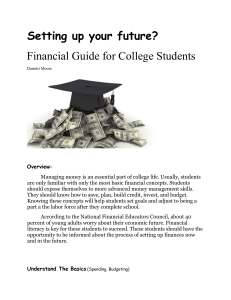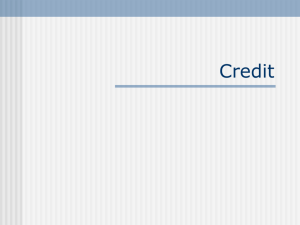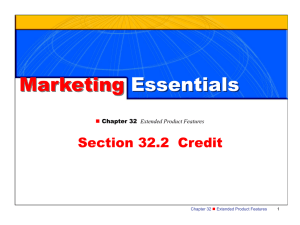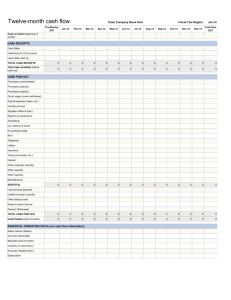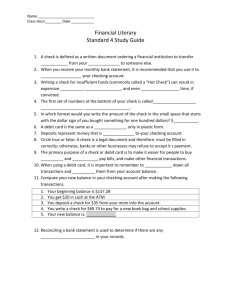Term Definition E-Banking Services of Financial Institutions
advertisement
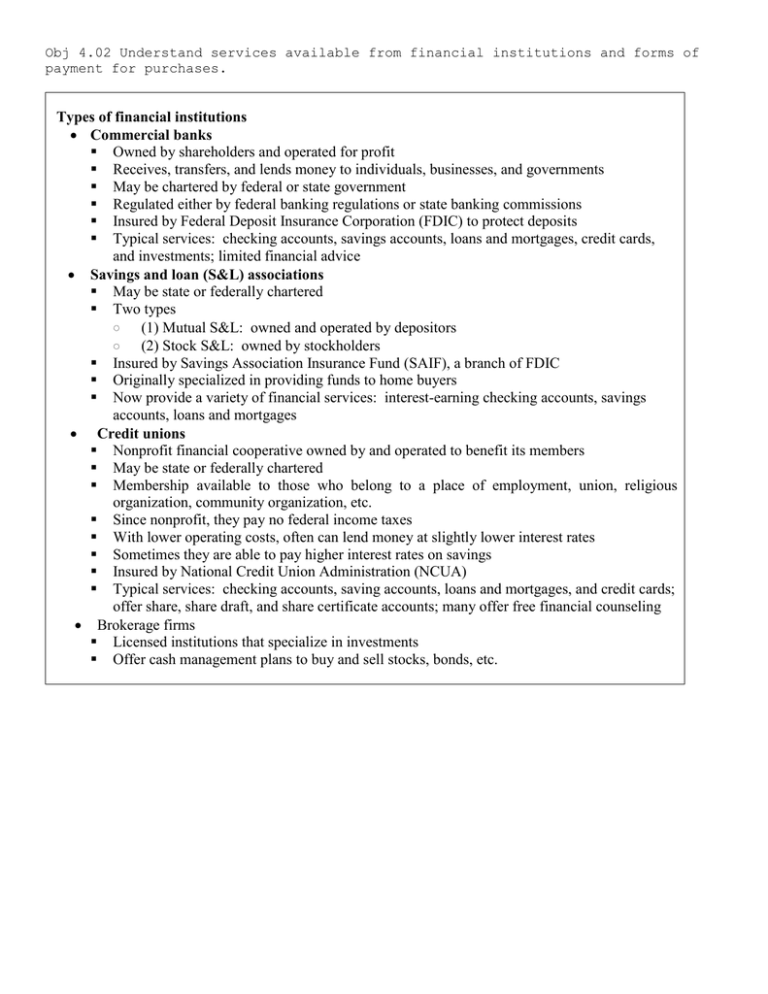
Obj 4.02 Understand services available from financial institutions and forms of payment for purchases. Types of financial institutions Commercial banks Owned by shareholders and operated for profit Receives, transfers, and lends money to individuals, businesses, and governments May be chartered by federal or state government Regulated either by federal banking regulations or state banking commissions Insured by Federal Deposit Insurance Corporation (FDIC) to protect deposits Typical services: checking accounts, savings accounts, loans and mortgages, credit cards, and investments; limited financial advice Savings and loan (S&L) associations May be state or federally chartered Two types (1) Mutual S&L: owned and operated by depositors (2) Stock S&L: owned by stockholders Insured by Savings Association Insurance Fund (SAIF), a branch of FDIC Originally specialized in providing funds to home buyers Now provide a variety of financial services: interest-earning checking accounts, savings accounts, loans and mortgages Credit unions Nonprofit financial cooperative owned by and operated to benefit its members May be state or federally chartered Membership available to those who belong to a place of employment, union, religious organization, community organization, etc. Since nonprofit, they pay no federal income taxes With lower operating costs, often can lend money at slightly lower interest rates Sometimes they are able to pay higher interest rates on savings Insured by National Credit Union Administration (NCUA) Typical services: checking accounts, saving accounts, loans and mortgages, and credit cards; offer share, share draft, and share certificate accounts; many offer free financial counseling Brokerage firms Licensed institutions that specialize in investments Offer cash management plans to buy and sell stocks, bonds, etc. Obj 4.02 Understand services available from financial institutions and forms of payment for purchases. OBJECTIVE: 4.02 B2 5% Understand services available from financial institutions and forms of payment for purchases. UNPACKED CONTENT Traditional services of financial institutions Benefits of using financial institutions Convenience Cost savings Safety and security Types of traditional services of financial institutions Accounts Checking account Savings account Retirement plan account Share account Share certificate account Share draft account Investments Bond Certificate of deposit Mutual fund Real estate investment Stock Loans Credit card Loan Mortgage Other traditional services Financial counseling Safe-deposit box E-banking services of financial institutions Using computer networks to make electronic funds transfers (EFT) among bank accounts Benefits of E-banking 24-hour access for moving money Fast, paperless, and convenient Worldwide access A variety of E-banking services available Types of E-banking services of financial institutions Point-of-sale (POS) transfers with a debit card Swiping plastic card at ATM or POS terminal provides access to EFT system Connected to the cardholder’s checking account and used for purchases At time of use, money taken from cardholder’s account to pay for purchase Transactions require a Personal Identification Number (PIN) Some are dual function, both ATM and POS (Point of Sale) Obj 4.02 Understand services available from financial institutions and forms of payment for purchases. OBJECTIVE: 4.02 B2 5% Understand services available from financial institutions and forms of payment for purchases. UNPACKED CONTENT E-banking services of financial institutions, continued Automated Teller Machine (ATM) Computer terminal for transacting business with a financial institution ATM card used to deposit and withdraw money from account Card protected with a PIN Usually open 24 hours a day Direct deposits A convenient way of depositing paychecks and benefit checks directly into a designated account Account-holder signs an authorization form to put this arrangement into place Direct withdrawals A convenient way of paying recurring bills directly from a designated account Used for fixed bills (home mortgages, car payments) or flexible bills (utilities) Account-holder signs an authorization form to put this arrangement into place Smart cards Plastic cards storing pre-paid amounts of money on computer chip Money automatically deducted from card when used for a purchase Reload additional money to the card as needed A variation of the smart card is the stored-value card, which is not reloadable; throw away when value is used up Forms of payment for purchases Payment in full at time of purchase Cash currency and coins Readily accepted in most places No hidden costs Convenient May be stolen or lost Payment with a personal check More secure than cash when sent through the mail Can only be used by the payee Provides a record of expenditures and legal proof of payment Payment with special-use checks Each type serves a specific purpose Cashier’s check---bought from a bank; payment guaranteed by the bank Certified check---a personal check with a bank’s guarantee of payment Money order---used to send money by mail by people who have no checking account Traveler’s check---used in place of cash when traveling; can be easily cashed in many places around the world; can be replaced if lost or stolen Available from most financial institutions, usually for a fee Obj 4.02 Understand services available from financial institutions and forms of payment for purchases. OBJECTIVE: 4.02 B2 5% Compare services available from financial institutions and forms of payment for purchases. UNPACKED CONTENT Forms of payment, continued Payment with debit card through point-of-sale transactions Making purchases with a debit card, both online and offline Must take precautions to protect against theft and fraud Sign back of card and write “See ID” Memorize and protect PIN; do not write where card is kept Be alert to surroundings and people nearby Payment through credit Open-end credit---credit cards Types: General purpose, company or retail store, travel and entertainment Can be issued by banks, savings and loan associations, credit unions, finance companies, insurance companies, and credit card agencies Provides accurate recordkeeping Convenient when ordering by mail or phone Pay for large purchases in small, monthly installments Can make purchases without carrying cash on your person May result in overspending High interest rates Card can be lost or stolen Fraudulent unauthorized charges may appear Closed-end credit---installment loans Types: car loans, student loans, home loans Granted by commercial banks, credit unions, finance companies, insurance companies, and credit card agencies Secured loans require collateral; unsecured loans on one’s signature alone, and often require a cosigner Borrow a stated amount and repay with interest in regular installments Obj 4.02 Understand services available from financial institutions and forms of payment for purchases. Key Terms: Types of Financial Institutions Term Definition Types of Financial Institutions Commerical bank A full-service financial institution that offers a variety of services Saving and loan association A financial institution that provides loans and mortgages to customers who hold a saving acount Credit union A nonprofit financial cooperative owned by its members Brokerage firm A licensed institution that specializes in investing. Insured financial institution One that is insured---as by Federal Deposit Insurance Corporation (FDIC), Savings Association Insurance Fund (SAIF), or Natioanl Credit Union Administration (NCUA) to protect deposits of clients Traditional Services of Financial Institutions Checking account Paper checks or debit cards are used to withdraw money deposited into the account to pay for items Savings account Money is deposited into an account to earn interest Retirement plan account A plan for saving money for retirement; money tax-deferred until withdrawn Share account A savings account at a credit union Share certificate account A certificate of deposit at a credit union Share draft account A checking account at a credit union Bond An investment of money in a government or organization Certificate of deposit An insured interest-earning savings tool with restricted access to funds Mutual fund Groups of stocks, bonds, and other investments managed by an investment firm Real estate investment Purchasing properties as an investment to gain profit Stock Ownership, represented by shares, in a corporation Credit card A card used to make a purchases; must be repaid later with interest Loan Borrowed money Mortgage A loan to purchase a home or other real estate Financial counseling Assistance to consumers with specific areas of financial planning Safe-deposit box A secured box in a bank used by clients for valuable personal items Obj 4.02 Understand services available from financial institutions and forms of payment for purchases. Appendix 4.02D, continued Key Terms: Types of Financial Institutions Term Definition E-Banking Services of Financial Institutions E-banking Using computer networks to make electronic funds transfers among accounts access The ability to obtain money from one’s accounts quickly and easily Point-of-sale (POS) transfer The place where a purchase is made and money is electronically moved Personal Identification Number (PIN) A unique number kept secured and used to access an account and perform transactions Automated Teller Machine (ATM) A computer terminal used to transact business with a financial institution Direct deposit Arrangement for electronically depositing pay/benefits directly into an account Direct withdrawal Arrangement for electronically withdrawing funds from an account to pay bills Smart card Card storing pre-paid amounts of money to use when making purchases Forms of Payment for Purchases Currency Paper money; bills Personal check A hand-written document used to pay for purchases using funds in a personal checking account Cashier’s check A check bought from a bank with payment guaranteed by the bank Certified check A personal check with a bank’s guarantee of payment Money order A way for people with no checking account to send money by mail Traveler’s check A check used in place of cash when traveling for greater security Debit card A card used for point-of-sale transactions on a checking account Credit card A card used for payment through credit with interest accruing Open-end credit A credit arrangement where the amount of money borrowed continues to change as payments are made and purchases are put on the credit card Closed-end credit A credit arrangement where the amount of money borrowed and the amount to be repaid per month are fixed at the time the installment loan is made
